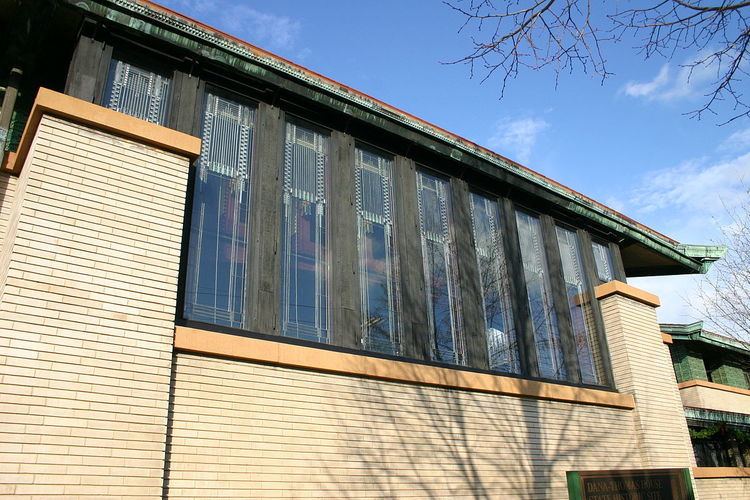Architectural style Other Designated NHL January 7, 1976 Phone +1 217-782-6776 | Built 1902 NRHP Reference # 74000774 Opened 1904 Added to NRHP 30 July 1974 | |
 | ||
Address 300 E Lawrence Ave, Springfield, IL 62703, USA Hours Closing soon · 9AM–5PMWednesday9AM–5PMThursday9AM–5PMFriday9AM–5PMSaturday9AM–5PMSunday9AM–5PMMonday10AM–2PMTuesday10AM–2PM Similar Frank Lloyd Wright Ho, Coonley House, Darwin D Martin House, Old State Capitol, Robie House | ||
The Dana–Thomas House or Susan Lawrence Dana House or Dana House (built 1902–04) is an expression of architect Frank Lloyd Wright's Prairie School. Located along East Lawrence Avenue in Springfield, Illinois, for patron Susan Lawrence Dana, the town house reflects the mutual affection of the patron and the architect for organic architecture, the relatively flat landscape of the U.S. state of Illinois, and the Japanese aesthetic as expressed in Japanese prints.
Contents
Susan Lawrence Dana
In 1902, Susan Lawrence Dana (1862–1946) was an independent woman and heiress to a substantial fortune, including silver mines in the Rocky Mountains. Widowed in 1900, Dana enjoyed complete control over her household and fortune. Eager to express her personality and to become the leading hostess in Springfield, Dana decided to completely remodel her family's Italianate mansion located in the state capital's fashionable "Aristocracy Hill" neighborhood.
Susan Lawrence Dana's search for an architect to match her aspirations ended when she was introduced to Frank Lloyd Wright, the rising leader of a new movement in architecture.
Selecting an architect
In 1893, Frank Lloyd Wright (1867–1959) left the office of his mentor, Louis Sullivan, and began to practice as an independent architect. Fully agreeing with Sullivan's doctrine of "organic architecture", Wright expanded it into a full-fledged system of congruence between the interior of a building and its surroundings, which came to be called the "Prairie Style".
Susan Lawrence Dana's 1902 commission to Wright to plan the "remodeling" of the Lawrences' Victorian mansion was the largest commission that Wright had enjoyed up to that time. The architect, who recognized a kindred spirit in Mrs. Dana, expanded the boundaries of his commission to design and build what was, in effect, an entirely new house.
Dana House
This house was a showcase for Wright's Prairie Style. It reflected Susan Lawrence Dana's flamboyant personality and Dana's and Wright's mutual love of Japanese prints and drawings. The house was designed for display and entertainment. An arched doorway admitted guests into a series of expanding spaces, the vestibule and reception hall.
The concept of "expanding space" was repeated throughout the house, with windows placed so as to continually draw the resident or guest into an awareness of the outside. Wright designed approximately 450 art glass windows, skylights, door panels, sconces, and light fixtures for the house, most of which survive. Much of the art glass, and the mural by George Niedecken surmounting the dining room interior, centered on a sumac motif.
A substantial west wing leads visitors through an interior Torii gate into two of the largest rooms in the house. The upper-level gallery was used for musical entertaining, and the ground-level library contains special easels designed by Wright for Dana to display selections from her collection of Japanese prints, part of more than 100 pieces of free-standing Wright-designed white oak furniture in the house.
Susan Lawrence Dana lived in the Dana–Thomas House for approximately 24 years, from 1904 until about 1928. At first a successful hostess and leader of Springfield's social scene, she later became increasingly reclusive and turned her attention to spiritualism and the occult. Suffering from increasing financial constraints in her later years, she closed the main house around 1928 and moved to a small cottage on the grounds. As Dana struggled with age-related dementia in the 1940s, her home and its contents were sold.
State historic site
Charles C Thomas, a successful medical publisher, was the second owner and custodian of the Dana–Thomas House in 1944–1975. A view of the building was featured on the title pages of some of his publications. Charles died in 1969 and his Wife Nanette died in 1975. He and his wife are credited with maintaining the house's original furnishings and design, and with selling the home and its furnishings as a unit to the state of Illinois in 1981 for $1.0 million, significantly less than could have been earned had the household been broken up.
The State of Illinois bought the house in 1981 and it became a historic site under the Illinois Historic Preservation Agency (IHPA). The IHPA led a restoration effort in 1987–1990 that refitted the house to its appearance in 1910. It is believed to contain one of the most intact Frank Lloyd Wright architectural interiors in the United States. Restoration plans and documents are held by the Ryerson & Burnham Libraries at the Art Institute of Chicago.
The house was featured in Bob Vila's A&E Network 1996 production, Guide to Historic Homes of America.
Temporary shutdowns
As part of a program of budget cuts, the state of Illinois temporarily closed the Dana–Thomas House to the public from December 1, 2008 until April 23, 2009. The Dana–Thomas House again closed for 11 months in 2011 for renovations to interior and exterior finish as well as mechanical and security systems.
